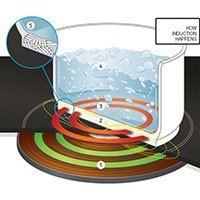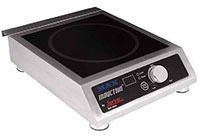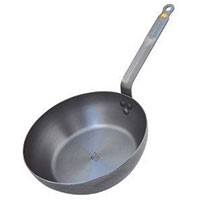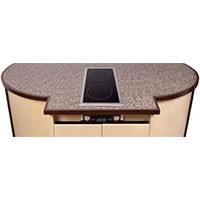Commercial Induction Range Buying Guide

Induction Range
Frying, Simmering, Searing, Sautéing
By Definition:
“Electricity, Magnetism. the process by which a body having electric or magnetic properties produces magnetism, an electric charge, or an electromotive force in a neighboring body without contact.”

Induction ranges are a great example of advancing cooking technologies. They operate by passing electricity from magnets (magnetic induction) to magnetic-grade materials (induction pans, certain grade stainless steel, etc). Because of this, the kitchen can be a safer workspace for continuous production. And more precise induction cooking is achieved with this electric range at a quicker rate.
While this guide is highlighting portable induction ranges due to their mobility, all of the following concepts apply to any commercial induction cooktop (except for mobility). For more technical information about how Induction works, check out the popular mechanics that explain everything from electromagnets to high-frequency currents.
1. What makes them efficient? Three reasons…

Electric, and mobile; are the first major factors that come to mind with induction ranges. This makes them available at most any time. No gas connection is required, so venues that aren’t yet set up for gas ranges, don’t need to suffer from a new install. This also means that any mobile operation such as a catering service can cook or heat on demand.
The first physical characteristic of induction ranges that you’ll notice, would be that they’re flat. Flat-top stoves became famous because they cooked evenly. They also cooked evenly over a period of time; versus coil burners that warp over time. This also makes them easier to clean. There is nothing to remove, just a nice flat surface.
Secondly, they heat exactly and “only,” induction ready or magnetic materials. Not only does this mean that there is a safety factor, but it means that if the entire pan is touching the cooktop, the entire pan is heated at the same temperature.
And lastly, there is an element of safety. Since induction cooktops only heat or “burn” magnetic or induction-ready material, you can count your hands and other materials “safe.” Again, this is provided that nothing magnetic or induction ready is in contact with the cooktop. Always treat an induction range as you would any normal commercial range. (electricity and heat are still involved with induction cooktops).
2. Cooking Type
Since they function as a multipurpose flat range, they can handle most range cooking types:
- Frying
- Boiling
- Simmering
- Searing
- Sautéing
You don’t want to use a “portable” induction range for non-stop heavy-duty cooking. This means all day boiling and similar types of cooking that require high output gas or 240v and higher ranges. As nice as it would be to be able to bring heavy boiling to any event, that and other types of heavy-duty cooking should stay in the commercial kitchen. There is still an induction option. Consider induction tops that are higher voltages which are typically part of a stove/oven combo.
Speaking of continuous work, this brings to attention, the need to consider letting your induction range breathe. Even though they are good for continuous work, use care by keeping the fan clean from debris and dust. Also, make sure there is room around the unit for airflow. These simple precautions will lengthen the age of the range and will keep it running like new.
3. What Do I Need?

It’s thought that induction ranges work only with induction label products. However, you may have the pots and pans already available in your cupboard. Please be aware that, it is for good reason that there are pots and pans made specifically for induction. While some metalwares may work, they may not work efficiently. But if it is the thought of redoing your pan collection that prevents you from going “induction,” don’t let it. Try induction out with what you (may) already have, then if it moves you to recollect your metals, you’ll do so while feeling positive about your choice. Most brands do not make all of their items to be induction ready, so be sure to research your product carefully before purchasing.
The following restaurant supplies are known to work with induction type cooktops:
- Induction Ready labeled wares
- Iron wares that are enameled or filled with iron flakes
- Cast Iron
- Magnetic grade stainless steel
4. Placement
This is where Induction ranges shine. Induction ranges are probably the most portable and useful type of cooking equipment. With low-output models available, they can be taken anywhere proper ventilation is present. Because of their mobility, they can be placed closer to the customers, providing a safer open cooking experience for them. (Remember that, while these are far safer than other equipment types, treat them as cooking equipment. Untrained staff should never use induction equipment.)
Some ranges are now equipped with induction burners that are able to provide this experience for the chef who is heavy-duty cooking in “back of house” operations. This brings the safety and convenience of the portable ranges. It also alleviates gas lines for venues that are not equipped with the possibility of gas appliances (gas lines, permits, etc).
5. You Should Know

Think outside of the box - some restaurants place their induction cookers under their countertops and/or on top of their tables. When this is done, it means the cooking is integrated into not only the furniture but also into the atmosphere of the establishment. This can maximize the customer experience and make the customer feel as if they are a part of the food being prepared for them.
Specifically, businesses that add their induction cookers under their countertops, usually do it for design purposes and therefore hire someone to create the stunning look they are wanting to achieve. At the same time, one might think that adding the cooker under their countertop, that it might make the unit not work properly or as well as above the countertop. However, that is not always the case.
Before you decide on whether you want a countertop, under-the-counter, or standalone induction cooker, ensure you consult with one of our experts, so we can point you in the right direction!
References:
https://www.dictionary.com/browse/induction
Share This!